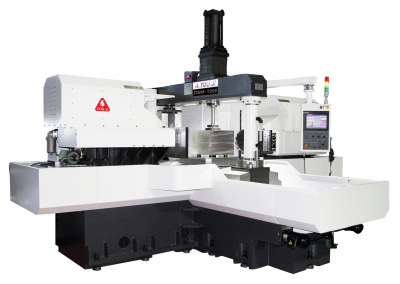
The DSM series of heavy-duty duplex milling machines from You Ji is engineered specifically for two-, four- or six-sided production squaring and chamfering of square and rectangular workpieces. Depending on the machine configuration chosen, end users can machine blocks as small as 0.750" x 0.750" (19.05 mm x 19.05 mm) and as large as 47" x 47" (1,175 mm x 1,175 mm) in maximum thicknesses ranging from 6" (150 mm with 10” cutter) to 16" (400 mm with 16.5” cutter).
The machines’ duplex spindle design enables simultaneous two-sided milling that produces consistent parallelism and perpendicularity as well as tight tolerances and fine surface finishes. Heavy, one-piece cast-iron machine bases are engineered via finite element analysis (FEA) modeling technology that optimizes machine rigidity and minimizes thermal displacement.
These duplex milling machines feature rotary worktables that move in the X-axis on roller-type linear ways and index from 0˚ to 315˚ at 45˚ intervals. Hydraulic clamping and Hirth couplings combine to produce positioning accuracy of +/-0.0003" and repeatability of 0.0002".
The machines’ twin milling heads move on rigid box ways along the Z-axis. The heads feature variable-speed NT50- or NT60-taper spindles and 15 or 30 hp, depending on the machine model. The spindles produce high levels of torque at low rpm, permitting effective use of large-diameter cutters.
Machine operation is semi-automatic, as workpieces are shuttled in manually then automatically centered, clamped and checked. Clamping pressure increases in steps to expedite accurate centering and provide sufficient clamping force to eliminate chatter. Clamping fixtures are modular and can be tailored to specific workpiece shapes.
Every DSM series machine utilizes a Mitsubishi C-70 control with a touch-screen interface and HMI (Human Machine Interface) customized to You Ji specifications. Operator-friendly software speeds setups and reduces changeover time by allowing subsequent jobs to be set up while machining is in process. A cutting memory module stores workpiece-material-based cutting data that can be applied to new parts.
Each DSM milling machine includes standard automatic measuring and positioning functions as well as a control cabinet heat exchanger, chip conveyor, semi-enclosed machine guarding, and ten sets of clamping fixtures. Optional features range from large-diameter milling cutters and a spindle chiller to full enclosure guards, a multi-tap transformer for high-voltage operation and additional clamping fixtures.
Contact Details
Related Glossary Terms
- centering
centering
1. Process of locating the center of a workpiece to be mounted on centers. 2. Process of mounting the workpiece concentric to the machine spindle. See centers.
- chamfering
chamfering
Machining a bevel on a workpiece or tool; improves a tool’s entrance into the cut.
- chatter
chatter
Condition of vibration involving the machine, workpiece and cutting tool. Once this condition arises, it is often self-sustaining until the problem is corrected. Chatter can be identified when lines or grooves appear at regular intervals in the workpiece. These lines or grooves are caused by the teeth of the cutter as they vibrate in and out of the workpiece and their spacing depends on the frequency of vibration.
- gang cutting ( milling)
gang cutting ( milling)
Machining with several cutters mounted on a single arbor, generally for simultaneous cutting.
- milling
milling
Machining operation in which metal or other material is removed by applying power to a rotating cutter. In vertical milling, the cutting tool is mounted vertically on the spindle. In horizontal milling, the cutting tool is mounted horizontally, either directly on the spindle or on an arbor. Horizontal milling is further broken down into conventional milling, where the cutter rotates opposite the direction of feed, or “up” into the workpiece; and climb milling, where the cutter rotates in the direction of feed, or “down” into the workpiece. Milling operations include plane or surface milling, endmilling, facemilling, angle milling, form milling and profiling.
- milling machine ( mill)
milling machine ( mill)
Runs endmills and arbor-mounted milling cutters. Features include a head with a spindle that drives the cutters; a column, knee and table that provide motion in the three Cartesian axes; and a base that supports the components and houses the cutting-fluid pump and reservoir. The work is mounted on the table and fed into the rotating cutter or endmill to accomplish the milling steps; vertical milling machines also feed endmills into the work by means of a spindle-mounted quill. Models range from small manual machines to big bed-type and duplex mills. All take one of three basic forms: vertical, horizontal or convertible horizontal/vertical. Vertical machines may be knee-type (the table is mounted on a knee that can be elevated) or bed-type (the table is securely supported and only moves horizontally). In general, horizontal machines are bigger and more powerful, while vertical machines are lighter but more versatile and easier to set up and operate.







